| Content Column |
|---|
| tabbed-blocks | tabs |
|---|
| width | .25% |
|---|
| id | 750601822 |
|---|
| |
| Content Column |
|---|
| | Content Block |
|---|
| name | Actions Menu |
|---|
| id | 224291244 |
|---|
|  Circulation > Actions menu Circulation > Actions menu
The Actions  dropdown menu contains specialized circulation functions such as the Advanced Bookings and Process Pending Bookings commands. dropdown menu contains specialized circulation functions such as the Advanced Bookings and Process Pending Bookings commands. Cash Drawer Balance. Enter the cash drawer Starting Balance, Start Date, End Date, and click Continue. The report totals your payments and refunds, and includes patron barcodes, dates and descriptions of charges, total refunds and/or payments, the initial drawer balance, and the new balance. | Example Report: 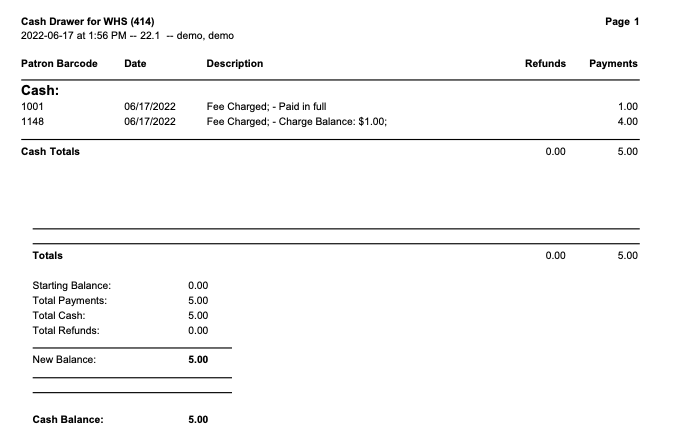
|
|---|
- Advanced Bookings. This will open the Advanced Bookings window, which allows you to process reservations that begin on or between two selected dates.

- Process Pending Bookings. This performs the Process Pending Bookings command, which checks to see if any of the unavailable items have recently become available. If they have, they're automatically assigned to the requesting patron.
| Expand |
|---|
| title | Click to view the old interface |
|---|
|
The Actions dropdown menu contains specialized circulation functions such as the Advanced Bookings and Process Pending Bookings commands. Cash Drawer Balance. If you dispense or collect cash for lost or damaged materials—i.e. refunds or payments—the Cash Drawer Balance selection helps tally your cash drawer and safeguards against loss. Provide the cash drawer Staring Balance, Start Date (date you want the report to begin), and End Date (through date that you want the report to cover) and click OK. The report totals your payments and refunds and performs all the calculations for you; results include patron barcode numbers, dates and descriptions of charges, total refunds and/or payments, the initial balance, and your new balance. | Example Report: | View file |
|---|
| name | cashDrawerReport.pdf |
|---|
| page | Example Reports (PDFs) |
|---|
| space | ALIB |
|---|
| height | 250 |
|---|
|
|
|---|
- Advanced Bookings. This will open the Advanced Bookings window, which allows you to process reservations that begin on or between two selected dates.
- Process Pending Bookings. This performs the Process Pending Bookings command, which checks to see if any of the unavailable items have recently become available. If they have, they're automatically assigned to the requesting patron.
- Log Out. Allows the Librarian to log out.
- Switch Site. This option is only available for libraries that are a part of a Centralized Catalog. It opens the Select A Site window, which allows an operator to select which site(s) they would like to log into; however, the choices offered depend on the sites that the operator has permission to access (review the Site Access window for more information). Therefore, an operator may have access to multiple sites, but not all the sites defined in the Sites Management window. The default selection in the window is always the last site that operator logged into.
|
|
| Content Block |
|---|
| name | Command Line |
|---|
| id | 224315168 |
|---|
| Select a Circulation Mode from the dropdown menu located to the left of the Command Line. The Circulation Mode field indicates which function will be implemented when patron/item barcodes are typed or scanned. Frequently used modes are Bookdrop (B), Check Out (.), Hold (H), and Renewal (R). 
The command line, located at the top-center of Circulation, is where you enter circulation commands or barcode numbers for patrons and items. If you enter only a barcode, the current Circulation Mode (shown to the left of the command line) will determine what action is performed. By default, the command line assumes that text input is a circulation command first and a patron/item barcode second. Override Date. An operator-provided Override Date can appear immediately after the Command Line. The function of an override date depends on the current Circulation Mode. | Expand |
|---|
| title | Click to view the old interface |
|---|
| Command LineSelect a Circulation Mode from the dropdown menu located to the left of the Command Line. The Circulation Mode field indicates which function will be implemented when patron/item barcodes are typed or scanned. Frequently used modes are Bookdrop (B), Check Out (.), Hold (H), and Renewal (R). 
Command LineThe command line, located at the top-center of Circulation, is where you enter circulation commands or barcode numbers for patrons and items. If you enter only a barcode, the current Circulation Management (shown to the left of the command line) will determine what action is performed. By default, the command line assumes that text input is a circulation command first and a patron/item barcode second. Override Date. An operator-provided Override Date can appear immediately after the Command Line. The function of an override date depends on the current Circulation Mode. Circulation Mode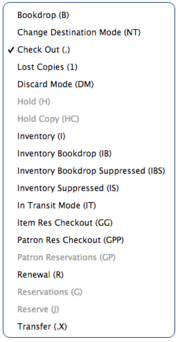
- Bookdrop (B). Used to check in items for one—or many—patrons.
- Change Destination Mode (NT). Note: This option is available only in Centralized Catalog systems. This changes the destination of copies whose Status is currently In Transit to somewhere else.
- Check Out (.). Typically used to check out library material to patrons however that depends on two things: the Check Out Options preference (which allows you to change the behavior of Check Out (.) mode), the “status” of the patron, and the item.
- Lost Copies (1). Used to move several copies to the Lost Copies System Patron (barcode # 1).
- Discard Mode (DM). Used to move several copies to the Discarded Copies System Patron and provide a note for each on why they are being discarded.
- Hold (H). This places a Hold on any items that are entered.
- Hold Copy (HC). This places a hold on a particular copy (specific item barcode) of a title for the current patron.
- Inventory (I). This updates the Inventory Date for all materials entered and triggers an alert for Circulation Exceptions.
- Inventory Bookdrop (IB). This updates the Inventory Date for all materials entered while simultaneously bookdropping them and triggers an alert for Circulation Exceptions.
- Inventory Bookdrop Suppressed (IBS). This updates the Inventory Date for all materials entered while simultaneously bookdropping them and bypasses any Circulation Exceptions alerts.
- Inventory Suppressed (IS). This updates the Inventory Date for each item entered and bypasses any Circulation Exceptions alerts.
- In Transit Mode (IT). This assigns checked out copies to the In Transit System Patron (barcode # 9). Afterward, the copy will be placed In Transit to its home library (whichever library is specified in the copy's Copy Site field).
- Item Res Checkout (GG). This is for checking out items that have been reserved by a patron; if the item is entered during a reservation date range it will be checked out to the patron who requested it and that patron will appear in the current patron pane.
- Patron Res Checkout (GPP). This checks out any reserved items a patron has if their patron barcode number is entered during the reservation date range and said item will appear in the current item pane.
- Patron Reservations (GP). This reserves a specific item (specific item barcode) for multiple patrons. This mode saves times when multiple patrons want to reserve the same item however it can't be used if there isn't a current item in the current item pane.
- Renewal (R). This renews currently checked out items.
- Reservations (G). This reserves a specified copy (specific item barcode) to the current patron for a specified date range.
- Reserve (J). This reserves a specified copy (specific item barcode) for the patron in the current patron pane. This mode can't be used if there isn't a patron in the current patron pane.
- Transfer (.X). This works exactly like the Check Out (.), with one exception: when the copy that is scanned is checked out to a patron other than your current patron, instead of allowing you to bookdrop the copy, the copy will be transferred to the current patron.
|
|
| Content Block |
|---|
| name | Current Patron |
|---|
| id | 751356519 |
|---|
|  Circulation > Current Patron pane Circulation > Current Patron pane To check out, hold, or reserve an item, you need to have a Current Patron pulled up in Circulation. The Current Patron pane shows important patron information such as barcode, name, checked out items, charges, and credits, as well as their grade, Lexile score, and reading level (when set in Preferences). Details: View and email or print the current patron's account details, including currently loaned items, holds, reservations, fees and other charges, and general information. You can choose whether or not to include cover art when viewing, emailing, and printing patron details. | Info |
|---|
Patron Details will show relevant details for Library or Textbook data, depending on which Circulation window you access it from. To view Textbook data from Librarian or vice versa, adjust your Circulation Preferences. |
| Tip |
|---|
Circulation's Patron Details is interactive! Say you want to renew an item or forgive a charge for the patron whose Details you're viewing. Simply click on that section's heading (i.e. "Items Out" or "Charge Summary") to be taken to the right place in Circulation. |
Lookup: Opens the Patron Lookup dialog, allowing you to search your database for patron records; performs the same action as using the “L” command. 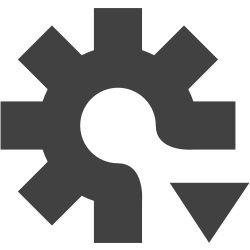 Actions Menu Actions Menu
- Reserves. Provides a list of the current patron's reserves; you can remove some or all reserves from the resulting Patron Reserves dialog.
- History. Runs an individual Patron History report, which shows recent payments, credits, renewals, lost items, refunds, Lexile history, and returned items. The PDF will automatically download. You can also run this report by clicking Show History in the
 Actions menu of Patrons Management. Actions menu of Patrons Management.
| Expand |
|---|
| title | Click to view the old interface |
|---|
| Current Patron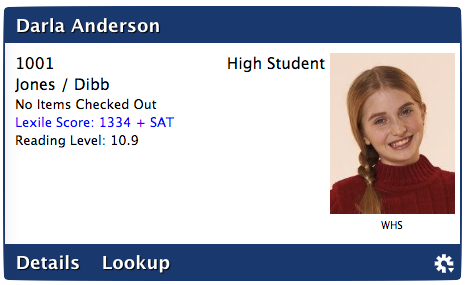
Many Alexandria functions and commands depend on the Current Patron or Current Item. For example, you must have a Current Patron to check out, hold, or reserve an item. The Current Patron pane consists of two areas: The larger, white area contains patron name, barcode, policy, homeroom, picture, and a short summary of the number of items checked out, on hold, reserved, with reservations, overdue, and the total fines or credits accrued; other things, such as the patron's current Lexile or Reading Level measurement, can be displayed here if you have your preferences set correctly.
The colored strip at the bottom of the pane contains buttons for Details and Lookup; the Actions menu located at the bottom-right contains identical (and some exclusive) selections. DetailsView and email or print the current patron's account details, including currently loaned items, holds, reservations, fees and other charges, and general information. You can choose whether or not to include cover art when viewing, emailing, and printing patron details. | Info |
|---|
Patron Details will show relevant details for Library or Textbook data, depending on which Circulation window you access it from. To view Textbook data from Librarian or vice versa, adjust your Circulation Preferences. |
| Tip |
|---|
Circulation's Patron Details is interactive! Say you want to renew an item or forgive a charge for the patron whose Details you're viewing. Simply click on that section's heading (i.e. "Items Out" or "Charge Summary") to be taken to the right place in Circulation. |
Lookup Opens the Patron Lookup dialog, allowing you to search your database for patron records; performs the same action as using the “L” command. Notes. Available when the current patron has associated contact, alert, categorical, or general notes. Notes are provided for patrons in the Notes tabs of Patrons Management. When clicked you are also able to add notes directly to the resulting Patron Notes dialog.
- Reserves. Provides a list of the current patron's reserves; you can remove some or all reserves from the resulting Patron Reserves dialog.
- History. Runs an individual Patron History report, which shows recent payments, credits, renewals, lost items, refunds, Lexile history, and returned items. The PDF will automatically download to your device. You can also run this report by clicking Show History in the
 Actions menu of Patrons Management. Actions menu of Patrons Management.
|
|
| Content Block |
|---|
| name | Current Item |
|---|
| id | 407454570 |
|---|
|  Circulation > Current Item pane Circulation > Current Item pane
 Image Removed Image Removed
The Current Item pane consists of two areas: The white area contains the copy, barcode, policy, call number, status, picture, and a short summary of available title copies. At the bottom, access the Copy List, Stats, item Lookup, and the actions menu. 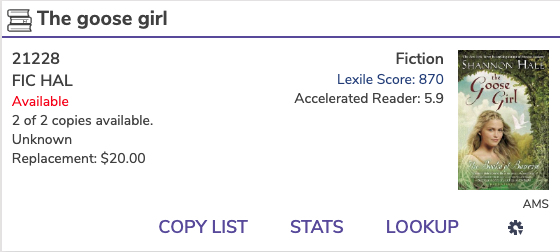 Image Added Image Added
Copy ListThe Copy List shows how many copies are available, the holds queue, and lists each copy's site, location, status, and details. It can be viewed or printed, and you can use the Q= command for quick access. Several parts of the Copy List are clickable: - Author's name. Performs an automatic item lookup by author.
- Open item details: Pulls up that title's Item Details.
- Patron names: Makes that patron current.
- Copy call numbers and barcodes: Makes that copy current.
Copy StatsSee the copy's checkout count, last use date, previous checkouts, and more with Copy Stats.
LookupEnter your search term and then scroll through your results below. In a Centralized Catalog, select the site you want to search from the dropdown menu in the bottom left corner of the dialog. To perform a "begins with" search, enclose a phrase in quotation marks and an asterisk. For example, you would type "har*" if you were looking for Harry Potter. You can also start a "begins with" search from the command line using the T command (e.g. T "har*"). 
- Details. Contains information about the item, including reviews, summary, links, genres, subjects, Study Programs, awards, and publisher information. It can be viewed, printed, or emailed. While viewing Item Details in Circulation, you can click on open copy list to pull up the Copy List or on the review stars to open Reviews Management. Use the QI command for quick access.
- Notes. Add a new note or view existing notes for the current copy. Copy Notes and Alert notes can be entered here or in Items > Copy Records.
- Reserves. A list of patrons who have the current copy reserved.
- Show Map. If the current copy's call number falls within the range of a corresponding map (created in Maps Management), selecting Show Map will display the the map, detailing where the copy is located in your library. These maps can be conveniently printed from your browser and handed to interested patrons. If the current copy lacks a call number (or there is no map with an associated call number range), Show Map is disabled.
- Vendors. This selection opens a secondary menu containing a list of Alexandria third-party partners that, when selected, link to their respective websites. Individual vendors can be disabled in Services Preferences.
| Expand |
|---|
| title | Click to view the old interface |
|---|
| Current Item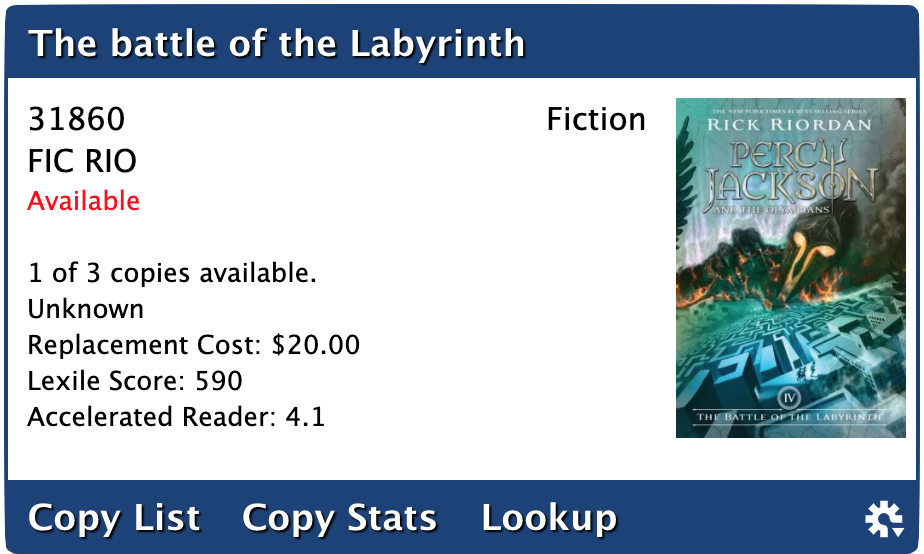
Many Alexandria functions and commands depend on the Current Patron or Current Item. You must have a Current Patron to check out, hold, or reserve an item. The Current Item pane consists of two areas: The white area contains the copy, barcode, policy, call number, status, picture, and a short summary of available title copies. The colored strip at the bottom of the pane contains some actions and helpful reports. Copy ListThe Copy List shows how many copies are available, the holds queue, and lists each copy's site, location, status, and details. It can be viewed or printed, and you can use the Q= command for quick access. Several parts of the Copy List are clickable: - Author's name. Performs an automatic item lookup by author.
- Open item details: Pulls up that title's Item Details.
- Patron names: Makes that patron current.
- Copy call numbers and barcodes: Makes that copy current.
Copy StatsSee the copy's checkout count, last use date, previous checkouts, and more with Copy Stats. LookupEnter your search term and then scroll through your results below. In a Centralized Catalog, select the site you want to search from the dropdown menu in the bottom left corner of the dialog. To perform a "begins with" search, enclose a phrase in quotation marks and an asterisk. For example, you would type "har*" if you were looking for Harry Potter. You can also start a "begins with" search from the command line using the T command (e.g. T "har*"). 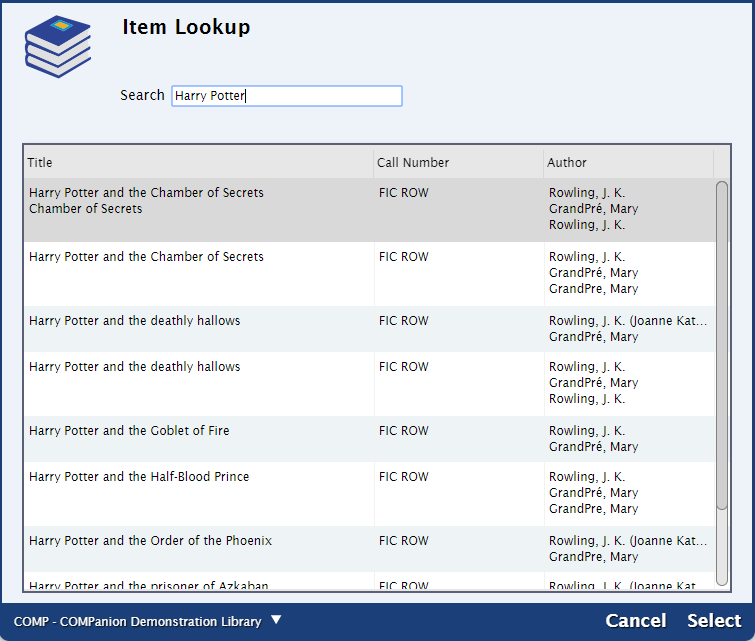
- Details. Contains information about the item, including reviews, summary, links, genres, subjects, Study Programs, awards, and publisher information. It can be viewed, printed, or emailed. While viewing Item Details in Circulation, you can click on open copy list to pull up the Copy List or on the review stars to open Reviews Management. Use the QI command for quick access.
- Notes. Add a new note or view existing notes for the current copy. Copy Notes and Alert notes can be entered here or in Items > Copy Records.
- Reserves. A list of patrons who have the current copy reserved.
- Show Map. If the current copy's call number falls within the range of a corresponding map (created in Maps Management), selecting Show Map will display the the map, detailing where the copy is located in your library. These maps can be conveniently printed from your browser and handed to interested patrons. If the current copy lacks a call number (or there is no map with an associated call number range), Show Map is disabled.
- Vendors. This selection opens a secondary menu containing a list of Alexandria third-party partners that, when selected, link to their respective websites. Individual vendors can be disabled in Services Preferences.
|
|
|
|